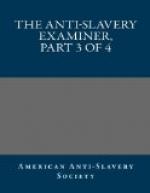We now present another class of facts and testimony, showing that the slaves engaged in raising the large staples, are overworked.
In September, 1831, the writer of this had an interview with JAMES G. BIRNEY, Esq., who then resided in Kentucky, having removed with his family from Alabama the year before. A few hours before that interview, and on the morning of the same day, Mr. B. had spent a couple of hours with Hon. Henry Clay, at his residence, near Lexington. Mr. Birney remarked, that Mr. Clay had just told him, he had lately been led to mistrust certain estimates as to the increase of the slave population in the far south west—estimates which he had presented, I think, in a speech before the Colonization Society. He now believed, that the births among the slaves in that quarter were not equal to the deaths—and that, of course, the slave population, independent of immigration from the slave-selling states, was not sustaining itself.
Among other facts stated by Mr. Clay, was the following, which we copy verbatim from the original memorandum, made at the time by Mr. Birney, with which he has kindly furnished us.
“Sept. 16, 1834.—Hon. H. Clay, in a conversation at his own house, on the subject of slavery, informed me, that Hon. Outerbridge Horsey, formerly a senator in Congress from the state of Delaware, and the owner of a sugar plantation in Louisiana, declared to him, that his overseer worked his hands so closely, that one of the women brought forth a child whilst engaged in the labors of the field.
“Also, that a few years since, he was at a brick yard in the environs of New Orleans, in which one hundred hands were employed; among them were from twenty to thirty young women, in the prime of life. He was told by the proprietor, that there had not been a child born among them for the last two or three years, although they all had husbands.”
The preceding testimony of Mr. Clay, is strongly corroborated by advertisements of slaves, by Courts of Probate, and by executors administering upon the estates of deceased persons. Some of those advertisements for the sale of slaves, contain the names, ages, accustomed employment, &c., of all the slaves upon the plantation of the deceased. These catalogues show large numbers of young men and women, almost all of them between twenty and thirty-eight years old; and yet the number of young children is astonishingly small. We have laid aside many lists of this kind, in looking over the newspapers of the slaveholding states; but the two following are all we can lay our hands on at present. One is in the “Planter’s Intelligencer,” Alexandria, La., March 22, 1837, containing one hundred and thirty slaves; and the other in the New Orleans Bee, a few days later, April 8, 1837, containing fifty-one slaves. The former is a “Probate sale” of the slaves belonging to the estate of Mr. Charles S. Lee, deceased, and is advertised by G.W. Keeton, Judge of the Parish of Concordia, La. The sex, name, and age of each slave are contained in the advertisement which fills two columns. The following are some of the particulars.




